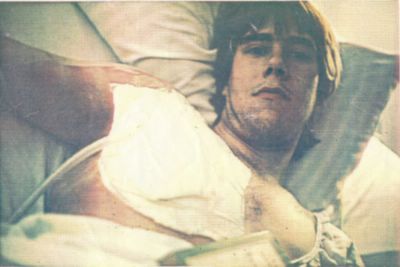
click to enlarge
It wasn't they so much as circumstance, my inexperience, the public hospital system, MedicAid, the New York Blackout and my poverty all colluding to nearly snuff me.
Son of Sam was on the loose in Brooklyn and Queens. The temperatures were in the upper 90s. I was on the job trail. On July 13, when I got back to our loft in Brooklyn, my back was killing me. I sat down and noticed it wasn't my back at all; it was my chest. My arm and back felt numb and I could barely breathe.
Was I having a heart attack? I called Keelin at the deli where she worked. "What should I do?" "Call 911!"
I called 911. I said I was having a heart attack. An hour later, no ambulance had arrived. I called again. Fifteen minutes later, a beat cop rang our buzzer. I let him in. I wasn't having a coronary, but something was really wrong. The friendly cop was able to raise an ambulance.
The ambulance brought me to the E.R. at Long Island College Hospital. It took the attending physician about five seconds to diagnose a spontaneous pneumothorax, or, a collapsed lung. People have collapsed lungs every day--usually athletes or people who've been jostled in an accident, or have been stabbed or shot.
A resident put a chest tube in, after giving me Novacaine to numb the scalpel's bite.
That night, the lights went out. From my window in the hospital I could see the World Trade Center. It was dark. The New York blackout of 1977 was on. Looting and fires broke out all over the city. Over 4,000 people were arrested. They re-opened The Tombs in downtown Manhattan, to warehouse all the arrestees.
At Long Island College Hospital, the backup generators fired up immediately. Alas, the air conditioning did not. It was around 104 degrees that day. It was at least 100 in the hospital by ten o'clock. The kitchen was closed, and they served us sandwiches and juice and fruit. It was the best food I would eat for three weeks.
It's not difficult to install a chest tube. I later learned how to do it advanced first aid. Yet, somehow, the hapless resident--Dr. Bucobo--f***ed it up. Normally, it takes a day or two for a collapsed lung to heal. It had been a week. Someone finally realized that the tube was in The Wrong Place. They chopped another hole in my chest and re-installed the tube. The resident and his intern came in once a day. If I survived these F-troop MDs, it would be a miracle.
Two days later, my new friend Jan Newberry, came to see me. I couldn't speak. I was in incredible pain. My fever was 104 and climbing. My breathing was shallow because it hurt to breathe. My blood gas was not promising. Jan called Keelin, who raced down and somehow convinced them they were killing me.
Things looked marginal for my continued existence. The pneumothorax was now complicated by double pneumonia. They hooked up a lung suctioning machine, put me on large doses of morphine, and pumped me full of vitamins, major antibiotics, stool softeners, sleeping pills every night, and other potions and elixirs. The morphine helped. When I was finally on antibiotics, the fever broke. After two grim days, I slowly began to recover. I was going to live. The only thing I cared about was the next dose of morphine.
After twenty days in LICH, the chest tube was removed. It felt great not to have to lug that box around (the chest tube ran into a box with water in it, which kept the lung pressurized as it repaired itself). The next day, they kicked me out. I was back on the streets of New York.
They caught Son of Sam the next month. He was our neighbor for a long time after that--we lived across the street from the Brooklyn House of Detention.
---o0o---
Jesus!
ReplyDelete